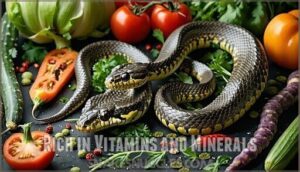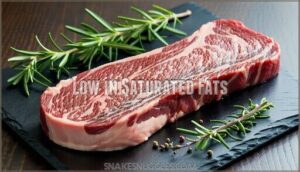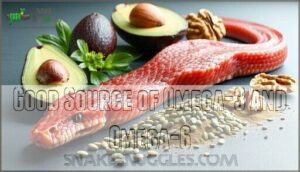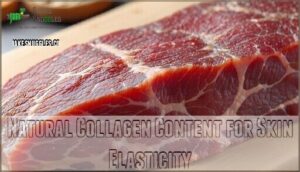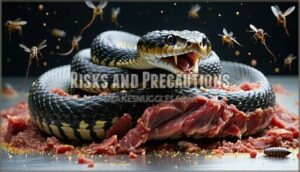This site is supported by our readers. We may earn a commission, at no cost to you, if you purchase through links.
 When you’re eyeing new protein sources, snake meat might surprise you with serious snake nutrition health benefits.
When you’re eyeing new protein sources, snake meat might surprise you with serious snake nutrition health benefits.
It packs high-quality protein, iron, zinc, and potassium without the heavy baggage of saturated fats or loads of calories.
You’ll get omega-3s and omega-6s to help your heart and joints, and there’s an unexpected dose of collagen for your skin.
If you cook it right, snake meat’s not just safe—it can be flavorful and satisfying.
Of course, just watch out for proper prep to keep things healthy.
Turns out, this slithery “superfood” has more going for it than most would guess—just wait till you see why.
Table Of Contents
- Key Takeaways
- Snake Nutrition Facts
- Health Benefits Explained
- Snake Meat Nutritional Value
- Risks and Precautions
- Culinary and Medicinal Uses
- Frequently Asked Questions (FAQs)
- What are the health benefits of eating snake meat?
- Does snake fruit have health benefits?
- Are venomous snakes healthy?
- What is the nutritional profile of snake meat?
- Is snake meat a good protein source?
- What are the benefits of salak (snake fruit)?
- What are the benefits of eating snake food?
- Does the snake plant have any health benefits?
- Is snake food healthy?
- Is snake fruit good or bad for you?
- Conclusion
Key Takeaways
- You’ll get a solid punch of protein, all nine essential amino acids, plus iron and vitamin B12 from eating snake meat, which is just what your muscles and brain crave.
- Snake meat is low in fat, which keeps your heart happy and your energy levels steady, making it a great option for those looking for a healthy protein source.
- You’ll find that snake meat is rich in omega-3s and omega-6s, which support heart health, and it’s also a good source of collagen, which can help with skin elasticity.
- When consuming snake meat, you’ll need to be aware of the potential health risks, such as venom contamination, parasites, and bacteria, so it’s crucial to handle and cook it properly to reap the snake nutrition health benefits.
Snake Nutrition Facts
When you look at snake meat, you’ll find it’s packed with high-quality protein, essential vitamins, and important minerals like iron and calcium.
It’s also low in saturated fat and offers healthy omega-3 and omega-6 fatty acids, making it a smart choice if you want a nutrient-rich meal that won’t bite back.
High Protein Content
In the context of high-protein diets, snake meat stands out for its impressive protein content.
You get:
- 20–26 grams of protein per 100 grams
- All nine essential amino acids for muscle synthesis
- High Protein Bioavailability for better absorption
- Strong satiety effects to help control appetite
Snake nutrition supports muscle repair, delivers premium protein quality, and adds real snake health benefits.
Ensuring proper vitamin D3 intake is also vital for calcium absorption.
Rich in Vitamins and Minerals
Snake meat’s vitamin and mineral profile makes it a nutritional powerhouse.
You’ll find high levels of vitamin B12, iron, zinc, and potassium that support energy production and immune function.
The vitamin bioavailability in snake meat exceeds many traditional proteins, while mineral absorption rates remain excellent.
These nutrient synergies help prevent deficiency symptoms and meet RDA considerations effectively.
Snake meat is also a delicacy in many regions and offers unique flavors and textures, providing unique flavors and delicacy options.
Low in Saturated Fats
Unlike beef that’s loaded with saturated fats, snake meat contains only 2-4 grams per 100 grams.
This lean protein won’t clog your arteries like traditional red meat. You’re getting healthy fats instead of the heart disease risk that comes with high saturated fat alternatives.
Snake meat’s low fat profile makes it a smart dietary fat comparison for cholesterol level impact.
Good Source of Omega-3 and Omega-6
Essential fatty acids make snake meat a nutritional powerhouse.
You’ll find omega-3 acids that support brain health and reduce inflammation, plus omega-6 for joint health.
This lean protein delivers healthy fats in balanced proportions.
Chinese water snake contains 20% EPA, while dietary balance comes from both fatty acid types working together for ideal wellness.
It’s also worth noting that snake meat is relatively low in calories and provides a good source of omega-3 acids.
Health Benefits Explained
When you eat snake meat, you’re giving your body a boost of protein, vitamins, and minerals that support muscle repair, heart health, and energy.
Fuel your body with snake meat’s complete protein, heart-healthy fats, and minerals for a powerful edge in energy and recovery.
You mightn’t expect it, but these nutrients also help your immune system, joints, and even your skin’s elasticity—no snake charming required.
Supports Muscle Repair and Growth
Your body needs protein to build and repair muscle tissue after workouts.
Snake meat delivers 20-26 grams of complete protein per 100 grams, providing all nine essential amino acids your muscles crave.
This protein synthesis powerhouse supports faster muscle recovery and growth factors that boost exercise performance, making it ideal for athletes and fitness enthusiasts with essential amino acids.
Promotes Heart Health and Energy
For a real energy boost and heart health, snake meat pulls its weight. Thanks to omega-3 and omega-6, you’ll see real Cholesterol Reduction and better blood pressure.
Plus, there’s a B-Vitamin Boost and plenty of Amino Acids for Stamina Enhancement. Calcium supplements for snakes are also essential for bone strength.
Here’s what you get:
- Potassium Benefits
- Omega3 and omega6
- Cholesterol Reduction
- B-Vitamin Boost
Boosts Immune System and Joint Health
Snake meat’s rich omega-3 fatty acids and antioxidant properties work together to reduce inflammation and support your immune system’s autoimmune response.
These nutrients provide arthritis relief by supporting cartilage health and promoting collagen production.
The immunostimulatory effects help your body fight off infections while reducing joint pain naturally, providing arthritis relief and supporting cartilage health.
Natural Collagen Content for Skin Elasticity
Your body naturally produces collagen, but snake meat gives this process a powerful boost.
Rich in amino acids, it helps your skin maintain elasticity and supports joint lubrication for better movement.
- Collagen Production – Essential amino acids fuel your body’s natural collagen synthesis
- Skin Hydration – Improved moisture retention keeps skin supple and youthful
- Wrinkle Reduction – Enhanced elasticity improvement helps minimize fine lines naturally
- Joint Lubrication – Better cartilage health reduces stiffness and discomfort
Snake Meat Nutritional Value
You’ll be surprised to learn that snake meat offers impressive nutritional advantages compared to traditional livestock options.
This sustainable protein source provides more efficient feed conversion and substantially lower environmental impact than conventional meat production, making it a highly efficient option.
Comparison to Traditional Livestock
When evaluating protein sources, you’ll find pythons outperform traditional livestock in resource efficiency.
They convert feed into weight gain more effectively than chickens and cattle while requiring minimal water consumption.
Python farming offers superior protein yield per unit of land usage compared to conventional livestock breeding.
| Metric | Python | Traditional Livestock |
|---|---|---|
| Feed Conversion | 9x more efficient | Standard efficiency |
| Water Requirements | Minimal consumption | High water needs |
| Protein Yield | 82% usable weight | Lower yield ratios |
This exotic meat represents a breakthrough in sustainable protein production.
Unlike cattle that demand extensive resources, snake meat delivers exceptional nutritional value with dramatically reduced environmental footprint.
For those exploring alternatives to chicken comparison studies, pythons demonstrate clear advantages in both efficiency and output potential.
Lower Environmental Impact and Sustainability
You’ll find snake farming uses 9 times less water than cattle while producing fewer greenhouse gases.
This resource efficiency comes from snakes’ ability to convert feed into meat more effectively than traditional livestock.
Their carbon footprint remains minimal due to lower waste production and reduced land requirements.
These sustainable farming practices make snake meat an eco-friendly eating option for sustainable food systems.
Maintaining proper snake habitat conditions is essential for their well-being.
Emerging as a Sustainable Alternative
You’re looking at the future of protein production.
Snake farming converts feed into meat 9 times more efficiently than cattle, requiring substantially less water and producing fewer greenhouse gases.
These exotic proteins offer a sustainable alternative to traditional livestock, meeting growing demand with minimal environmental impact.
Farmed snake meat provides controlled, consistent quality compared to wild-caught options, making it a preferable choice for those seeking high-quality meat.
Supports Global Protein Demand
Global protein demand is expected to double by 2050, and you’ll need sustainable protein sources to feed everyone.
Snake meat delivers complete amino acids with exceptional feed efficiency—converting feed to protein 9 times better than cattle.
This exotic protein requires less water and produces fewer greenhouse gases, making it a viable future demand solution for protein alternatives.
Risks and Precautions
While snake meat offers impressive nutritional benefits, you’ll need to understand the serious health risks before considering it as food.
Improper handling can expose you to deadly venom, dangerous parasites, and harmful bacteria that could land you in the hospital.
Venom Contamination and Health Risks
While snake meat offers impressive nutritional benefits, venom contamination poses serious health risks you can’t ignore.
Even after death, some species retain bite aftermath reflexes that can inject deadly toxins. Venom potency varies dramatically between species, making proper identification essential for cooking safety.
- Species variation affects venom toxicity levels and post-mortem dangers
- Bone hazards include residual venom contamination in skeletal remains
- Bite aftermath risks persist even in severed snake heads during preparation
Parasites, Bacteria, and Heavy Metals
Beyond venom risks, you’ll face parasites, bacteria, and heavy metal contamination when consuming snake meat.
Parasites like trematodes lurk in snake mouths, while Salmonella thrives in their guts.
Heavy metals accumulate differently based on location – South Carolina snakes show higher mercury levels than others.
Proper parasite prevention and understanding bacterial contamination sources help avoid foodborne illnesses through safe sourcing practices.
Regular veterinary check-ups are essential for early parasite detection to ensure safe sourcing practices.
Proper Handling and Cooking Techniques
In the context of snake preparation, you can’t cut corners with safety. Proper venom neutralization and bone removal are your first line of defense against serious health risks.
Here’s your essential snake cooking checklist:
- Remove all bones carefully – Snake bones can contain residual toxins even after death, so thorough deboning prevents contamination
- Cook to 165°F internal temperature – This safe temperature kills parasites and bacteria while guaranteeing thorough venom neutralization
- Use proven cooking methods – Grilling, stewing, or frying at high heat breaks down harmful compounds effectively
Snake meat requires specialized handling skills. Always wear gloves during preparation and never rush the process. Think of it like defusing a bomb – one wrong move and you’re in trouble.
To guarantee safe bone removal, consider using specialized deboning tools.
Risk of Allergic Reactions and Foodborne Illnesses
After handling and cooking snake meat, you’ll still want to watch out for foodborne illnesses and allergic reactions.
Allergy symptoms like rashes or swelling can sneak up unexpectedly.
Bacterial contamination and parasitic infections are real snake risks, especially if you skip cooking precautions.
For safe consumption, always cook thoroughly, watch for signs of trouble, and know your body’s limits with new foods, to avoid allergic reactions.
Culinary and Medicinal Uses
You’ll find snake meat in everything from hearty soups to traditional remedies, showing up on both dinner tables and in medicine cabinets across Asia.
It’s surprisingly versatile, soaking up spices and flavors while offering nutrients that support your health, even if it mightn’t win any beauty contests.
It provides a range of benefits, but the text does not specify them, however the key point is that snake meat is versatile.
Traditional Asian Dishes and Remedies
If you’re curious about Asian cuisine, you’ll find snake soup at the heart of many traditions.
Revered for its medicinal beliefs and cultural significance, this dish pops up in Chinese medicine and old-school remedy books.
Preparation methods vary, but skilled chefs turn snake meat into recipes believed to boost health.
These traditional medicine practices highlight remedy effectiveness and history.
Modern Nutrition and Health Benefits
You’ve probably seen snake on a menu and thought it’s just old-school cuisine, but today, snake meat is earning a reputation in modern nutrition circles for good reason.
Packed with sustainable protein and excellent nutrient bioavailability, you get:
- High collagen benefits
- Potent vitamins and minerals
- Modern applications for global impact
- Impressive snake meat health benefits
Absorbs Marinades and Spices Well
Snake meat acts like a blank canvas for flavor enhancement, soaking up any spices or marinades you throw at it.
Its mild texture and natural juiciness bring out the best in recipe adaptations.
You’ll notice snake flavor shifts with cooking techniques, from grilled to stewed, which gives you tons of culinary versatility and options to create bold taste profiles in snake recipes.
Various Cooking Methods and Recipes
When you’re ready to try snake recipes, you’ve got options.
Grilling snake over hot coals brings a smoky kick, while a slow-cooked snake stew softens each bite.
Fried snake is crunchy outside, tender inside, and snake curry loves bold spices.
Classic snake soup warms you up.
Many are now looking at specialty snake products to enhance their culinary experience.
Always follow safe snake meat preparation tips for tasty, safe snake food preparation.
Frequently Asked Questions (FAQs)
What are the health benefits of eating snake meat?
You’ll get a solid punch of protein, all nine essential amino acids, plus iron and vitamin B12—just what your muscles and brain crave.
Low in fat, snake meat keeps your heart happy and your energy levels steady.
Does snake fruit have health benefits?
Like biting into a crunchy treasure chest, you’ll find snake fruit loaded with fiber, vitamins A and C, and antioxidants.
It’s an energy booster, sharpens memory, and even keeps digestion moving—no snake oil here!
Are venomous snakes healthy?
You should exercise caution with venomous snakes, as their meat can pose serious health risks if not handled and cooked properly, due to potential venom contamination.
What is the nutritional profile of snake meat?
You’ll find snake meat is high in protein, low in fat, and rich in essential vitamins and minerals, making it a unique and nutritious food option worth trying.
Is snake meat a good protein source?
You’re diving into protein sources like a fish into water; snake meat offers 20-26 grams of protein per 100 grams, making it a viable, high-protein option for your diet.
What are the benefits of salak (snake fruit)?
You’ll benefit from salak’s rich nutrients, including protein, potassium, and fiber, which support digestion, energy, and heart health, making it a nutritious and tasty addition to your diet.
What are the benefits of eating snake food?
Verily, you’ll discover snake food offers high protein, low calories, and essential vitamins, making it a nutritious, sustainable option for those seeking a unique culinary experience with potential health perks.
Does the snake plant have any health benefits?
You’ll discover snake plants have air-purifying properties, reducing toxins and promoting healthier indoor spaces, while also being low-maintenance and easy to care for, making them a great addition.
Is snake food healthy?
You’ll find that snake food, like snake fruit, offers nutritional value, but its health benefits depend on the type, preparation, and consumption methods used, considering risks and sustainability factors carefully.
Is snake fruit good or bad for you?
You’ll be pleased to know that snake fruit is good for you, offering a nutrient-rich snack with various health benefits, including high fiber and antioxidant content, boosting energy and digestion.
Conclusion
You’ll be surprised to know that 70% of the world’s population already consumes snake meat.
Now, you can reap the snake nutrition health benefits too, with its high protein, omega-3s, and collagen content.
Making it a superfood that supports heart health and skin elasticity, so give snake nutrition health benefits a try.
- https://www.calorieking.com/au/en/foods/f/calories-in-game-snake-raw/871emyGKTGCcuv5YS0w6Jg
- https://www.snapcalorie.com/nutrition/fried_snake_nutrition.html
- https://www.technologynetworks.com/applied-sciences/news/are-snakes-the-new-high-protein-superfood-384874
- https://enviroliteracy.org/animals/what-does-snake-meat-contain/
- https://www.discoverychepe.com.mx/en/articles/gastronomy/snake-meat-properties


